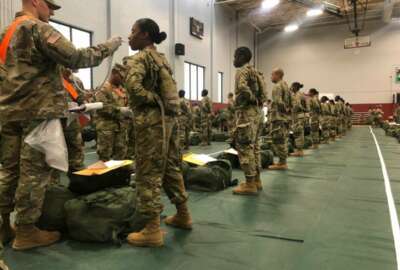Air Force meeting recruitment goals, changing mindset around work and training
The Air Force will hit its goal of recruiting 42,000 people in 2021.
As the Air Force is on track to meet recruiting goals for the first time in five years, signaling a welcome change as the military branch continues to grow and adds a sister service.
The Air Force is on track to eke over its goal of bringing on 42,000 recruits in 2021, just as the fiscal year is about to end in a little over a week.
The service’s active duty component has not had too much trouble in getting the bodies it needs — it’s hit its goal every year since 1999.
The reserve and National Guard components have not been as successful, however.
“Have to say, I’m pretty excited about making end strength for the first time in my tenure,” said Lt. Gen. Richard Scobee, chief of the Air Force reserve, during a roundtable with reporters at the Air Force Association Conference.
The numbers have been bleak for recruiters as less and less young Americans are interested in joining the military. A recent study from the Defense Department found that only 11% of young adults have an interest in the military.
The Air Force is also seeing extremely high retention rates due to the economic uncertainty of the global pandemic. Scobee said the less people leaving the active duty component, the less of a pool the reserve has to bring those people into the fold.
The service has changed its tack in recent years when it comes to recruiting as well. Gen Z is worried about things like climate change, work-life balance and being treated more like a human than a cog in a wheel.
The Air Force has changed some of its policies to deal with that by adding more parental leave and relaxing uniform standards. It’s also made a big push to increase diversity and inclusion by doing follow up studies to its original report on race mandated by the Defense Department.
It’s making overtures to Gen Z in unorthodox ways as well.
The Air Force has its own video gaming team, which travels and competes in contests. It also live streams events and uses games as an entry point to talk to children.
The Space Force is being explicit about its work-life balance and career opportunities. It’s new human capital strategy focuses on recruiting people who are not inclined to go into the military, prioritizes work-life balance and uses data to better place guardians.
“We must think differently about talent management for the Space Force to be successful,” the strategy reads. “We are creating a regulated market approach to talent management that integrates and strengthens equity, development, and human dignity. It empowers individuals to pursue pathways that are informed by both their preferences and an understanding of Space Force requirements. To that end, we are designing and implementing a new talent management approach to tap into and build upon each person’s unique strengths to power interconnected high-performing teams.”
The strategy allows permeability within the service and professions so that members are not stuck in one profession they decided on when they were 18 years old. It also will attempt to cater to people interested in specific fields to follow their passions and give the military a wide array of options and colors for its needs.
Space Training and Readiness Command, which stood up last month, is thinking not only about work-life balance, but how much of training and work can be virtual.
“One of the things that we need to think about is what training events do we need to do as live events?” STARCOM commander Brig. Gen. Shawn Bratton said.
He added that the Space Force is not a service that needs to deploy to an operational environment very often. Guardians will mostly work at computers and therefore in-person training is not imperative.
“What we need to think about is how do we improve in the virtual space so that the training is as good or equal to what they see on orbit?” Bratton said.
Copyright © 2025 Federal News Network. All rights reserved. This website is not intended for users located within the European Economic Area.
Scott Maucione is a defense reporter for Federal News Network and reports on human capital, workforce and the Defense Department at-large.
Follow @smaucioneWFED






